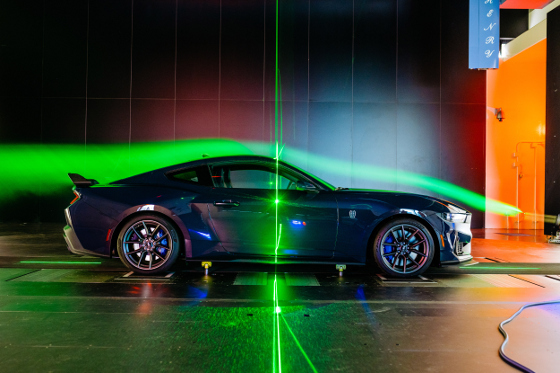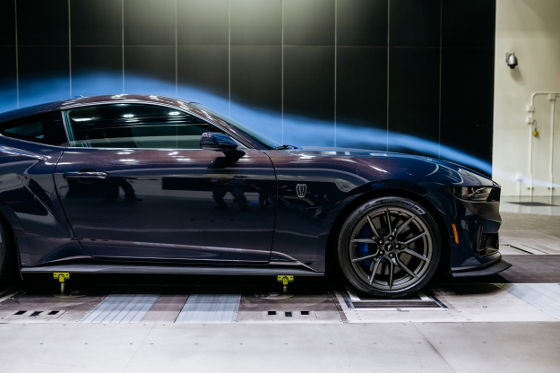 |
| August 22, 2023 | Volume 19 Issue 32 |
Designfax weekly eMagazine
Archives
Partners
Manufacturing Center
Product Spotlight
Modern Applications News
Metalworking Ideas For
Today's Job Shops
Tooling and Production
Strategies for large
metalworking plants
200-mph wind tunnel treadmill: New tool used by Ford Mustang Dark Horse designers

Mustang Dark Horse at Ford's Rolling Road Wind Tunnel in Allen Park, MI. [Credit: Ford]
Wind tunnels have long been used to design and test aerodynamic and energy-efficient vehicles. Ford Motor Co. has combined the latest wind tunnel technology with the equivalent of a vehicle-sized treadmill on a huge turntable to help create its next generation of production vehicles, including the all-new Mustang Dark Horse.
Capable of simulating wind and road surface speeds of 200 mph, the Rolling Road Wind Tunnel (RRWT), located in Allen Park, MI, supports testing for efficient and performance-driven vehicles across the Ford lineup -- including the next generation of Ford electric, hybrid, and gas vehicles.
"The amount of air moved by our wind tunnel is enough to fill a K-Class blimp in just over 5 seconds," says John Toth, North America Wind Tunnels Engineering Supervisor at Ford.
According to a Hemmings.com article, "Airflow is generated by an 85,000-pound motor with 12 carbon blades that push out 5 million cubic-feet of air per minute. Crosswinds are simulated by the turntable design, which can rotate by 30 degrees clockwise or counterclockwise."
Detroit News adds the wind tunnel is "fed by a 26-foot tall, 7,000-horsepower wind turbine" that is "driven by a 5.4-megawatt motor," and the "nickel-coated" turntable "is separated by just 1.5 millimeters from the surrounding floor."
Ford said back in 2017, when the 13-acre facility was first announced, that the temperature-controlled wind tunnel facility was a $200 million investment. Things got officially rolling at the test center in January 2022.

Rolling Road Wind Tunnel fan. [Credit: Ford]
Ford says one key benefit of the RRWT is that it gives more accurate data in terms of both wind drag and downforce compared to other earlier wind tunnel designs, which are key factors when optimizing for range and efficiency. It also allows for more in-house testing that simulates open-road conditions, which can help reduce design costs while also accelerating the design process.
"The closer we can get to reality in the lab, the better and faster we can create more energy-efficient vehicles with great on-road and track stability," says Toth. "Testing while the wheels and tires move is instrumental to improving aerodynamics for track-ready vehicles, like Mustang Dark Horse, which has to balance both aerodynamic drags and downforce."
The new five-belt rolling road system can replicate real-world drag through a rolling road aerodynamic tunnel that enables Ford to bring the road to the vehicle, rather than the vehicle to the road.


Rolling Road Wind Tunnel with Mustang Dark Horse. [Credit: Ford]
A 2023 SAE Technical Paper on the wind tunnel facility states, "The wind tunnel features an interchangeable single belt and 5-belt Moving Ground Plane (MGP) system with an integrated 6-component balance, a two-position nozzle, boundary layer removal systems, and two independent flow traverse systems. Each flow traverse has a large horizontal box beam and vertical Z-strut that can position the flow traverse accurately within the test volume.
"The individual traverse systems can also operate in tandem and have the capability to perform stereo PIV measurements and scale model vehicle testing, including vehicle passing or drafting simulations. The MGP can be quickly changed between single-belt and 5-belt operations, requiring only a single eight-hour shift to transition between the two configurations."
To test for optimal aerodynamic performance, each wheel gets its own belt, making up the first four belts. A large fifth belt runs under the center of the vehicle. A crane is used to switch between the multi-belt and single-belt systems. The single belt, which operates at up to 200 mph, opens up a new breed of testing for high-speed performance vehicles.
An Auto Blog article posted on Yahoo adds some more interesting details: "... there's a five-belt treadmill with four smaller belts for each wheel, and a center one to simulate the effects of the road passing under the car. To switch out these belts, there is an enormous crane that lifts them out and drops them in. Such a crane is needed as the five-belt setup weighs around 70,000 pounds, and the single-belt is around 90,000."

Ford Rolling Road Wind Tunnel wider view. [Credit: Ford]
Maximizing downforce on Mustang Dark Horse
The Mustang Dark Horse is among the first of many vehicles to be tested in this wind tunnel.
Tailored aerodynamics are a key step in the development of new vehicles. For passenger vehicles and trucks, the goal is to achieve low drag, creating a more efficient vehicle. However, for vehicles such as the Mustang Dark Horse where the priority is track-ready performance, aerodynamicists will trade low drag for increased downforce, which helps cars stick to the road or track and improves handling feel while cornering.
VIDEO: Testing the Mustang Dark Horse at the the Rolling Road Wind Tunnel (RRWT). [Video credit: Ford. Video posting credit: DPCcars]
The Mustang Dark Horse comes with an available Gurney flap, which is an extra plate attached to the rear wing to help generate additional downforce, as well as three vertical plates coming off the under body near each front wheel called strakes. The strakes help disrupt airflow, generating greater downforce on the underside of the vehicle, which can help the car stick better in corners at higher speeds.

Rolling Road Wind Tunnel control room. [Credit: Ford]

In this close-up detail of the control room, you can just make out the turntable position on the screen, with the large, overhead crane depicted too. [Credit: Ford]
Overall, Mustang Dark Horse includes multiple changes and additional features, including a redesigned front bumper, a lower valence, a spoiler, and unique wheels. The front design is optimized to increase air flow for engine cooling, brakes, and air intake, while also reducing front lift. The lower air spoiler and splitter are also unique, allowing the car to be tuned for greater downforce. The upgraded handling package on the Dark Horse provides a unique splitter, spoiler, and wheels -- changes that may seem small but make all the difference when hitting the road or track with performance in mind.

Aero Visualization: Mustang Dark Horse. [Credit: Ford]
"We spent approximately 250 hours in the wind tunnel developing the 2024 Ford Mustang, which includes Dark Horse," says Jonathan Gesek, Program Aerodynamicists for Mustang and Bronco. "The aerodynamics of Mustang Dark Horse along with several other factors have created the most track- and street-capable 5.0-liter Mustang to date."
The Mustang Dark Horse features a uniquely engineered fourth-gen Coyote V8 engine with 500 hp and 418 ft-lb of torque to set a new benchmark for Mustang street and track performance, and the most powerful non-Shelby edition ever.
Sources: Ford, Hemmings.com, Detroit News, SAE, Auto Blog, DPCcars (video posting)
Published August 2023
Rate this article
View our terms of use and privacy policy
